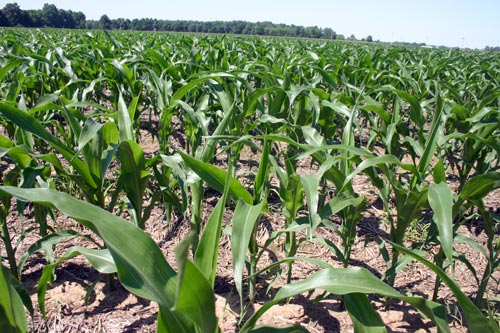January 24, 2012

What is the best herbicide for corn planted into fields with an overwhelming Palmer amaranth soil seed bank? There are two key aspects to manage heavy glyphosate-resistant Palmer infestations in corn. First is to use at least two herbicides with good activity on Palmer amaranth. The second is to use those herbicides in a split application.
The number one herbicide combination used on corn in Tennessee is atrazine and glyphosate. In 2008, Eric Prostko and others at the University of Georgia confirmed atrazine and glyphosate resistance in the same Palmer amaranth plant. Utilizing a glyphosate and atrazine tank-mix on fields with a huge Palmer seed bank greatly increases the probability of finding a Palmer pigweed in our state resistant to both atrazine and glyphosate. We cannot afford for that to happen.
That is why we must use at least two modes of action effective on Palmer pigweed in corn. Fortunately there are many herbicides in corn that will control Palmer applied pre, post or both. Some of these are Dual Magnum, Frontier, Harness, Callisto, Laudis, Impact, Status, 2,4-D, simazine and, of course, atrazine. Because there are so many herbicides that can be used in corn that can control Palmer amaranth, it really matters more how they are applied than which herbicides are used. In general, the herbicides should be applied in some kind of split application.
Some producers are not aware that traditional pre herbicides in corn like Bicep, Lexar, Harness Extra, Degree and Extra can be applied postemergence in corn. They can be applied post and they provide better pigweed control applied in this fashion. A good method is to apply one-third of the labeled rate for the soil type pre-emergence and then follow up early post emergence with the other two-thirds of the labeled rate. This typically provides the most consistent pigweed control.
Moreover, the newer premixes that contain a bleacher herbicide like Halex GT and Capreno work very well postemergence in corn after atrazine or simazine has been applied pre-emergence. The bleaching mode of action-based herbicide premixes provide the best control on Palmer when atrazine is mixed with them.
Unfortunately, Palmer amaranth control does not end there even if weed control early in the corn growing season was successful. Corn can hide late-emerging Palmer pigweed. Anywhere light can hit the ground expect Palmer to emerge once the herbicide has played out. In areas where the corn is thin, Palmer can emerge as early as June and will grow 6 feet tall and produce a lot of seed.
Later as the corn is drying down, Palmer amaranth will emerge well into September or later and even small Palmer can produce some seed. Therefore, weed control must be maintained even after corn harvest. This can be accomplished with tillage or a herbicide. Regardless of how it is done, the only way to reduce the soil seed bank is to minimize the Palmer pigweed seed production throughout the entire year.
You May Also Like




